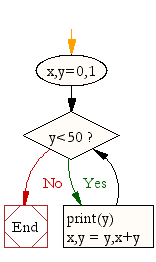- 0-Introduction
- 1-Chatbot Variables
- 2-Password IF Statements
- 3-Create Main Menu functions
- 4-Complete Quiz 3 Questions
- 5-Adding Score variable global
- 6-Debug this code
- 7-Introducing While loops Boolean flags
- 8-Introducing Validation password creation
- 9a-For Loop Guess the number
- 9b-For Loop Password Challenge
- 9c-For Loop Times table challenge
- FINAL CHALLENGE
- Skills Consolidation Task 1
- Test 1
- 0-Introduction
- 1-Introducing Lists
- 2-Personality Predictor Lists app
- 3-Players assigned weapons lists
- 3a-Nested List Matrix Snakes and Ladders game
- 3b Nested List Super Extension Complete game
- 4-String Manipulation Username Creator
- 5-StringManipulation Email Creator based on Validated username
- 6-Strip characters from password app
- 7-Create registration feature using lists
- 8-Introducing Dictionaries registration with dicts
- 8a-Course teacher finder program with dicts
- 9a-Football Club app Create and Learn
- 9b-Online Shopping Basket Checkout Program Create and Learn
- Test 1
- 0-Introduction
- 1-Introducing File Handling
- 2-READ from fake facebook file
- 3-SEARCH for username return no of friends
- 4-SEARCH by ID return full record listing
- 5-ADD WRITE a new user to file
- 6-SORT file by USER ID and Last Name
- 7-Bingo game store scores
- 8-Modulo Magic Program
- 9-Create Maths Quiz Program Tutorial
- 9a-How-to-DELETE user record row from file
- 9b-How to EDIT a field in a file
- Test 1
- 00 Intro
- 01 Main Menu Start Screen
- 02 Registration Feature Part1
- 03 Secure Password Creator
- 04 Login Functionality
- 05 MainFilms Menu Members
- 06 Allow Users to View films
- 07 Store Viewed Films by user
- 08 Allow users to like films
- 09 Search by Title
- 10 Search by Rating
- 11 Recommendations based on viewing FinalSolutions
- 00 Overview Start Here
- 01 Connect Create table
- 02 Add records to table
- 03 Fetch Display records
- 04 Update database records
- 05 Delete records
- 06 Search by condition where clause
- 07 Search for key phrase word
- 08 Sorting in SQLite
- 09 Search return selected fields
- 10 Count no rows
- 11 Find Max Value in column
- 12 Calculate Average
- 13 Calculate SUM total
- 14 Login username password sqlite
- 00-Introduction to OOP and Classes
- 01-Setup Game Canvas
- 02-Create a Ball Class
- 03-Setup main animation loop
- 04-Make the ball move up
- 05-Create bouncing ball movement
- 06-Change Starting Direction
- 07-Right left wall collision detection
- 08-Add Pong bat paddle class
- 09-Bat movement
- 10 Bat Ball collision detection
- 11 End Game Feature if ball hits bottom
- 12 Display text game over
~ Solve Problems and Learn how to code in Python
1 - Introducing File Handling in Python -Reading and Writing (searching/sorting) from files
Ready? Make a note of the documentation, presentation and information below and then get started on the challenges
Note: You may not be able to take in all the information on file handling below in at one glance or sitting, but keep in mind that you may want to start the challenges and keep coming back to this information to see if you can find what you need to solve the problem. It's all here and with the information provided you should be able to solve not just this challenge, but ANY challenge /problem that involves file handling in python!
What would we do without files? Check out this video on facebook servers. Ever wondered where all the data you save/store/read on facebook is stored? Here's where! File handling is key in programming, as it deals with working with files and storing data. Without files, we are simply running code but when the program stops and the computer is switched off, we're left with nothing! Saving is essential, and where do we save stuff? In files. On to the challenges soon ....
Presentation - File Handling
Official Python 3 Documentation
Why do we need to read and write from files?
A file is some information or data which isn't lost when you switch off your computer! It is stored externally in your computer storage which means it can be accessed whenever you want. You already know about different kinds of file , like your music files, video files, text files. You can only imagine the sort of massive "files" that an organisation like facebook holds on each of us! Python gives you easy ways to manipulate these files. Generally we divide files in two categories, text file and binary file. Text files are simple text where as the binary files contain binary data which is only readable by computer.
Code your solution here
Systems Life Cycle (in a nutshell): Analyse - Design - Create - Test - Evaluate. Designing something or writing out some pseudocode before you actually write code is always a good idea! Get in to the habit of doing so! You can draw your flowchart here and screenshot it.A sample flow chart (design) for this particular challenge could look like:

Each challenge section below provides an online drawing tool where you can dynamically create flowcharts. Screenshot them into your presentation for submission.
Solutions & Answers
Answers /Solutions in the "members area" drive under: "Solve and Learn >>SOLUTIONS"Testing Table
You may want to read a little about Testing first. A teacher may go through some examples with you. Feel free to fill in the test table here, and screenshot it in to your powerpoint. Testing is absolutely essential once you have created a program!| Test No. | Description | Test Data(input) | Expected Outcome | Actual Outcome | Further Action? |
|---|---|---|---|---|---|
| 1 | |||||
| 2 | |||||
| 3 | |||||
| 4 | |||||
| 5 |